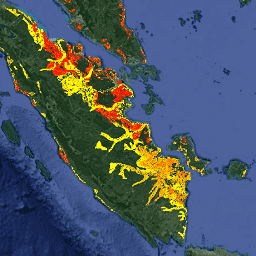
- در دسترس بودن مجموعه داده
- 1992-01-01T00:00:00Z–2018-01-01T00:00:00Z
- ارائه دهنده مجموعه داده
- فائو سازمان ملل
- آهنگ
- 1 سال
- برچسب ها
توضیحات
دو مجموعه داده مرتبط فائو در مورد خاکهای آلی زهکشی شده تخمینی از موارد زیر را ارائه می دهند:
DROSA-A: مساحت خاکهای آلی (در هکتار) زهکشی شده برای فعالیتهای کشاورزی (زمین زراعی و مرتع چرا)
DROSE-A: تخمینهای کربن (C) و اکسید نیتروژن (N2O) (بر حسب گیگاگرم) از زهکشی کشاورزی خاکهای آلی در این کاربریها.
داده های سالانه با وضوح 0.0083333 X 0.0083333 (~1 کیلومتر در خط استوا)، با پوشش جهانی برای دوره 1992 - 2018 در دسترس است.
برآوردهای FAOSTAT از پانل بین دولتی دستورالعمل های تغییر آب و هوا (IPCC) پیروی می کند و از هیستوسول ها به عنوان نماینده ای برای حضور خاک های آلی و نقشه های سالانه پوشش زمین به عنوان جزء وابسته به زمان استفاده می کند. علاوه بر این، ویژگی های خاک، کاربری زمین و اطلاعات آب و هوا در تجزیه و تحلیل استفاده می شود. انتشار کربن را می توان به CO2 تبدیل کرد و مقادیر پیکسل را در نسبت وزن مولکولی دی اکسید کربن (CO2) به وزن C (44/12) ضرب کرد.
خاک های آلی در اکوسیستم های خاک مرطوب رشد می کنند. آنها عبارتند از تورب زمین های گرمسیری و شمالی، باتلاق های با عرض جغرافیایی بالا، سرخس ها و منجلاب ها. خاک های آلی در سطح جهان تنها 3 درصد از مساحت زمین را پوشش می دهند، اما تا 30 درصد از کل کربن خاک را تشکیل می دهند، بنابراین نقش مهمی در حفظ تعادل کربن زمین دارند. کشاورزی عامل اصلی زهکشی خاکهای آلی در سراسر جهان است. زهکشی مواد آلی خاکهای آلی را در معرض شرایط هوازی قرار می دهد که اکسید می شود و مقادیر زیادی گازهای گلخانه ای مضر (GHG) را در جو آزاد می کند.
DROSA-A و DROSE-A مبنایی برای آمار کشوری و منطقه ای در مورد خاک های آلی زهکشی شده هستند که در سه مجموعه داده FAOSTAT (کشت خاک های آلی، زمین های زراعی و علفزار) منتشر شده اند.
باندها
اندازه پیکسل
927.67 متر
باندها
| نام | واحدها | اندازه پیکسل | توضیحات |
|---|---|---|---|
cropland | در هکتار | متر | مساحت خاک های آلی زمین های زراعی (هیستوسول) |
grassland | در هکتار | متر | مساحت خاکهای آلی مرتع (هیستوسول) |
شرایط استفاده
شرایط استفاده
سازمان خواربار و کشاورزی ملل متحد (فائو) موظف به جمع آوری، تجزیه و تحلیل، تفسیر و انتشار اطلاعات مربوط به تغذیه، غذا و کشاورزی است. در این راستا، تعدادی پایگاه داده در مورد موضوعات مرتبط با مأموریت فائو منتشر می کند و استفاده از آنها را برای اهداف علمی و تحقیقاتی تشویق می کند. مطابق با اصول باز بودن و اشتراک پیشبینی شده تحت مجوز دادههای باز برای پایگاههای داده آماری، و مطابق با دستور فائو، دادههای مربوط به انتشار گازهای گلخانهای ناشی از فعالیتهای کشاورزی در خاکهای ارگانیک به عنوان بخشی از FAOSTAT - پایگاه داده فائو در مورد دادههای غذا و کشاورزی، به صورت رایگان در اختیار جامعه کاربران قرار میگیرد.
نقل قول ها
FAO 2020. خاکهای آلی زهکشی شده 1990 - 2019. روندهای جهانی، منطقه ای و کشوری. سری مختصر تحلیلی FAOSTAT شماره 4، فائو، رم. http://www.fao.org/3/cb0489en/cb0489en.pdf
Conchedda، G. و Tubiello، FN: زهکشی خاک های آلی و انتشار گازهای گلخانه ای: اعتبارسنجی با داده های کشور، Earth Syst. علمی Data Discuss، 2022، doi:10.5194/essd-12-3113-2020
DOI
با Earth Engine کاوش کنید
ویرایشگر کد (جاوا اسکریپت)
var dataset = ee.ImageCollection('FAO/GHG/1/DROSA_A'); var visualization = { bands: ['cropland'], min: 1.0, max: 60.0, palette: ['white', 'red'] }; Map.setCenter(108.0, -0.4, 6); Map.addLayer(dataset, visualization, 'Cropland area drained (Annual)');
